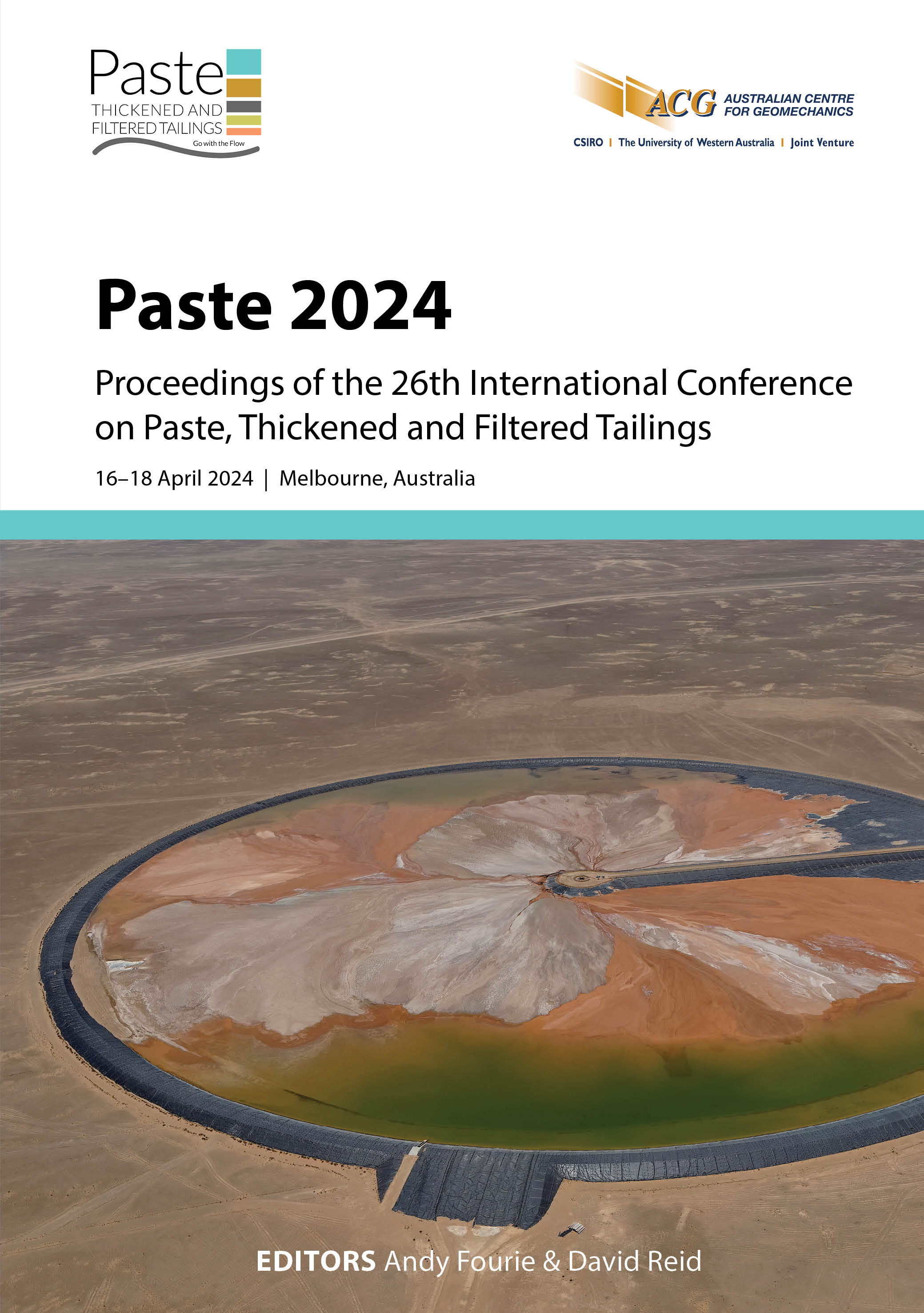Advances in dam breach analysis appropriate for dewatered tailings storage facilities

|
Authors: Seyedan, S; Arenas, A; Llano-Serna, M |
DOI https://doi.org/10.36487/ACG_repo/2455_20
Cite As:
Seyedan, S, Arenas, A & Llano-Serna, M 2024, 'Advances in dam breach analysis appropriate for dewatered tailings storage facilities', in AB Fourie & D Reid (eds), Paste 2024: Proceedings of the 26th International Conference on Paste, Thickened and Filtered Tailings, Australian Centre for Geomechanics, Perth, pp. 247-256, https://doi.org/10.36487/ACG_repo/2455_20
Abstract:
Dam breach analysis is an instrument that allows owners and designers to assume a failure of the tailings storage facility (TSF) and estimate its impact. The International Council of Mining & Metals recommendation is to base a breach analysis on credible failure modes. Historically the techniques to undertake dam breach analysis have been extrapolated from the water dam industry, assuming that tailings flow like water (i.e. a Newtonian fluid). Nevertheless, hydraulically deposited tailings may be more likely to present non-Newtonian behaviour. In addition, dewatered tailings constitute an additional layer of complexity in tailings flow properties. For example, dewatered tailings are more likely to develop particle-to-particle interaction, and hence, dilative and contractive properties of tailings are expected to play a more significant role during a potential dam breach. The last decade has seen the flourishing of non-Newtonian techniques and numerical packages. These techniques can better estimate the potential impact of non-Newtonian flows and have resulted in improved breach analysis for conventional TSFs. This study presents the results of a dam breach analysis applicable to dewatered tailings using the mud farming technique. The TSF is a project located in northern Australia. Mud farming was adopted to construct a structural zone upstream of the conventionally built embankments. To investigate the credible failure modes, runout, and loss of freeboard estimation, an emerging technique called the material point method was applied to capture large deformations such as those seen during dam breaching.
Keywords: mud-farmed tailings, dam breach, liquefaction, tailings, consequence classification.
References:
Blight, GE & Fourie, AB 2003, ‘A review of catastrophic flow failures of deposits of mine waste and municipal refuse’, International Workshop on Occurrence and Mechanisms of Flows in Natural Slopes and Earth Fills, Patron Ed, Sorrento.
Bowker, LN & Chambers, DM 2015, The Risk, Public Liability & Economics of Tailings Storage Facility Failures, Earthworks, Washington,
Facility Failures-23Jul15.pdf
Cabrera, HC 2020, Assessment of Farming Method Applied to Bauxite Residue Using a Laboratory Model, MPhil thesis, The University of Queensland, St Lucia.
Canadian Dam Association 2021, Technical Bulletin: Tailings Dam Breach Analysis.
Fern, EJ & Soga, K 2016, ‘The role of constitutive models in MPM simulations of granular column collapses’, Acta Geotechnica, vol. 11, no. 3, pp. 659–678,
Kafash, MH, Cerna-Diaz, A, Yenne, L & Davidson, R 2023, ‘Back analysis of runout mechanism of a static liquefaction induced failure using the material point method’, Proceedings of Tailings and Mine Waste 2023, The University of British Columbia, Vancouver.
Lines, S, Llano, M, Rekowski, R & Ludlow, W 2023, ‘Identification and analysis of a complex layer within the footprint of a tailings storage facility foundation utilising mini-block sampling‘, Proceedings of Mine Waste and Tailings Conference, Brisbane.
Llano-Serna, MA, Farias, MM & Pedroso, DM 2016, ‘An assessment of the material point method for modelling large scale run-out processes in landslides’, Landslides, vol. 13, no. 5, pp. 1057–1066,
Munro, LD & Smirk, DD 2018, ‘How thick is thick enough?’, in RJ Jewell & AB Fourie (eds), Paste 2018: Proceedings of the 21st International Seminar on Paste and Thickened Tailings, Australian Centre for Geomechanics, Perth, pp. 23–34,
Pierce, I 2021, Applying the Material Point Method to Identify Key Factors Controlling Runout of the Cadia Tailings Dam Failure of 2018, MPhil thesis, Virginia Tech, Blacksburg.
Robertson, PK, de Melo, L, Williams, DJ & Wilson, GW 2019, Report of the Expert Panel on the Technical Causes of the Failure of Feijão Dam I,
Seyedan, S & Sołowski, WT 2021, ‘From solid to disconnected state and back: Continuum modelling of granular flows using material point method’, Computers & Structures, vol. 251, no. 106545,
Smirk, DD & Jackson, S 2010, ‘In situ foundation improvement for upstream raising of embankments using dried tailings’, in R Jewell & AB Fourie (eds), Mine Waste 2010: Proceedings of the First International Seminar on the Reduction of Risk in the Management of Tailings and Mine Waste, Australian Centre for Geomechanics, Perth, pp. 251–260,
Soga, K, Alonso, E, Yerro, A, Kumar, K & Bandara, S 2016, ‘Trends in large-deformation analysis of landslide mass movements with particular emphasis on the material point method’, Géotechnique, vol. 66, no. 3, pp. 248–273.
Sołowski, WT, Berzins, M, Coombs, WM, Guilkey, JE, Möller, M, Tran, QA, … & Soga, K 2021, ‘Material point method: Overview and challenges ahead’, Advances in Applied Mechanics, vol. 54, pp. 113–204,
Sulsky, D, Chen, Z & Schreyer, HL 1994, ‘A particle method for history-dependent materials’, Computer Methods in Applied Mechanics and Engineering, vol. 118, no. 1–2, pp. 179–196,
Sulsky, D, Zhou, S-J & Schreyer, HL 1995, ‘Application of a particle-in-cell method to solid mechanics’, Computer Physics Communications, vol. 87, no. 1–2, pp. 236–252,
Tran, QA, Grimstad, G & Ghoreishian Amiri, SA 2023, ‘MPMICE: A hybrid MPM‐CFD model for simulating coupled problems in porous media. Application to earthquake‐induced submarine landslides’, International Journal for Numerical Methods in Engineering,
United States Society on Dams 2022, Analysis of Seismic Deformations of Embankment Dams.
Yerro, A, Soga, K & Bray, J 2019, ‘Runout evaluation of Oso landslide with the material point method’, Canadian Geotechnical Journal, vol. 56, no. 9, pp. 1304–1317,
© Copyright 2025, Australian Centre for Geomechanics (ACG), The University of Western Australia. All rights reserved.
View copyright/legal information
Please direct any queries or error reports to repository-acg@uwa.edu.au
View copyright/legal information
Please direct any queries or error reports to repository-acg@uwa.edu.au
